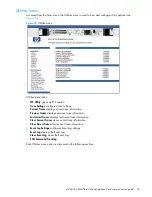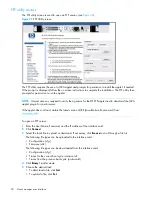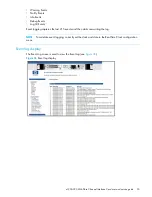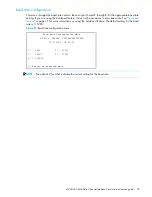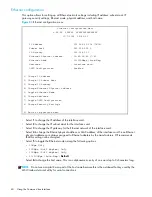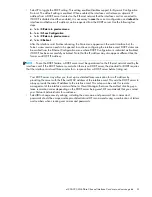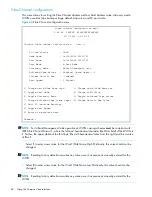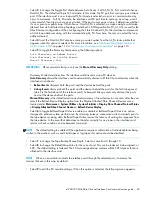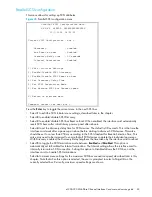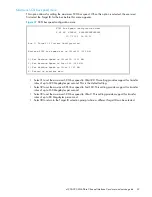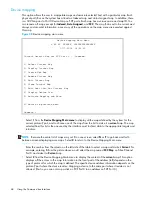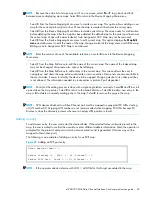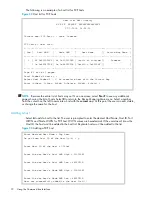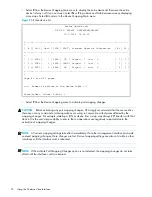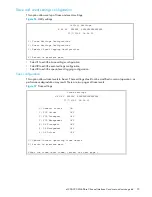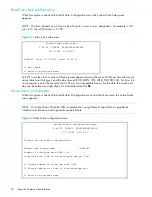
e1200-320 4Gb Fibre Channel Interface Card user and service guide
63
•
Select
3
to change the Toggle Port Mode between Auto Sense - Soft AL_PA, N_Port, and Auto Sense -
Hard AL_PA. The default setting is N_Port mode. In this mode, the FC port tries coming up as a fabric
port. If the interface card is on a loop and N_Port mode is selected, an error in communication may
occur. In Autosense - Soft AL_PA mode, the interface card FC port tries to come up as a loop, and if
not successful, then tries to come up as a fabric. If the port comes up as a loop, it determines whether
it’s on a private or public loop. If Auto Sense - Hard AL_PA is selected, a unique one-byte valid value
(derived from an Arbitrated Loop Topology as defined in ANSI specification FC_AL 4.5) is used for the
Fibre Channel configuration. When configuring the Fibre Channel AL_PA, the interface card presents
a list of loop addresses along with the corresponding AL_PA. From here, the user can select the loop
address desired.
•
Select
4
to set the Hard AL_PA Value by entering a node number from the AL_PA lookup table that
appears when this option is selected. For more information, see ”
Arbitrated Loop Node number to
AL_PA lookup table
” on page 114 in ”
Addressing, structures, and operations
” on page 113.
•
Select
5
to toggle the Discovery Mode among the following options:
Auto Discovery on Reboot Events
Auto Discovery on Link Up Events
Manual Discovery Only
IMPORTANT:
HP recommends that you only use the
Manual Discovery Only
setting.
Discovery Mode determines how the interface card discovers a new FC devices.
Auto Discovery
allows the interface card to automatically discover all Fibre Channel devices when the
interface card reboots.
•
Reboot Events
discovers both the ports and the devices behind the ports.
•
Link-up Events
discovers both the ports and the devices behind the ports for the first link-up event
(which is the first reboot of the interface card). Subsequent link-up events only discover the ports
and not the devices behind the ports.
Manual Discovery
is the default selection and sets discovery of new devices to only occur after the user
selects the Refresh Device Display option from the Display Attached Fibre Channel Devices menu,
located under
Main menu > System Utilities > System Statistics > Display Fibre Channel Protocol Status
> Display Attached Fibre Channel Devices > Refresh Device Display
.
•
Select
6
to toggle Buffered Tape Writes to enabled or disabled. Buffered Tape Writes is an option
designed to enhance system performance. By returning status on consecutive write commands prior to
the tape device receiving data, Buffered Tape Writes remove the latency of waiting for responses from
the tape device. In the event that data does not transfer correctly for any reason, the interface card
returns a check condition on a subsequent command.
NOTE:
The default setting is enabled. If the application requires confirmation of individual blocks being
written to the medium, such as audit trail tapes or log tapes, this option should be disabled.
•
Select
7
to change the Tape Backup Queue Depth. Select a value from 0 through 10.
•
Select
8
to change the Default Map Value for the current port. This can be Indexed, Auto-assigned, or
SCC. The default setting is Indexed. The FC Auto-assigned map contains all the SCSI devices that are
attached to the interface card.
NOTE:
When a new initiator contacts the interface card through the selected port, it accesses the
devices that are in this map by default.
•
Select
9
to edit the FC override settings. When this option is selected, the following menu appears.
Содержание StorageWorks e1200-320
Страница 26: ...26 Device management ...
Страница 30: ...30 Interface card management ...
Страница 92: ...92 Using the FTP interface ...
Страница 98: ...98 Troubleshooting ...
Страница 102: ...102 Serial and Ethernet pin assignments ...
Страница 108: ...108 Regulatory compliance and safety ...
Страница 122: ...122 Enabling DHCP on the HP e1200 320 4Gb FC Interface Card ...

